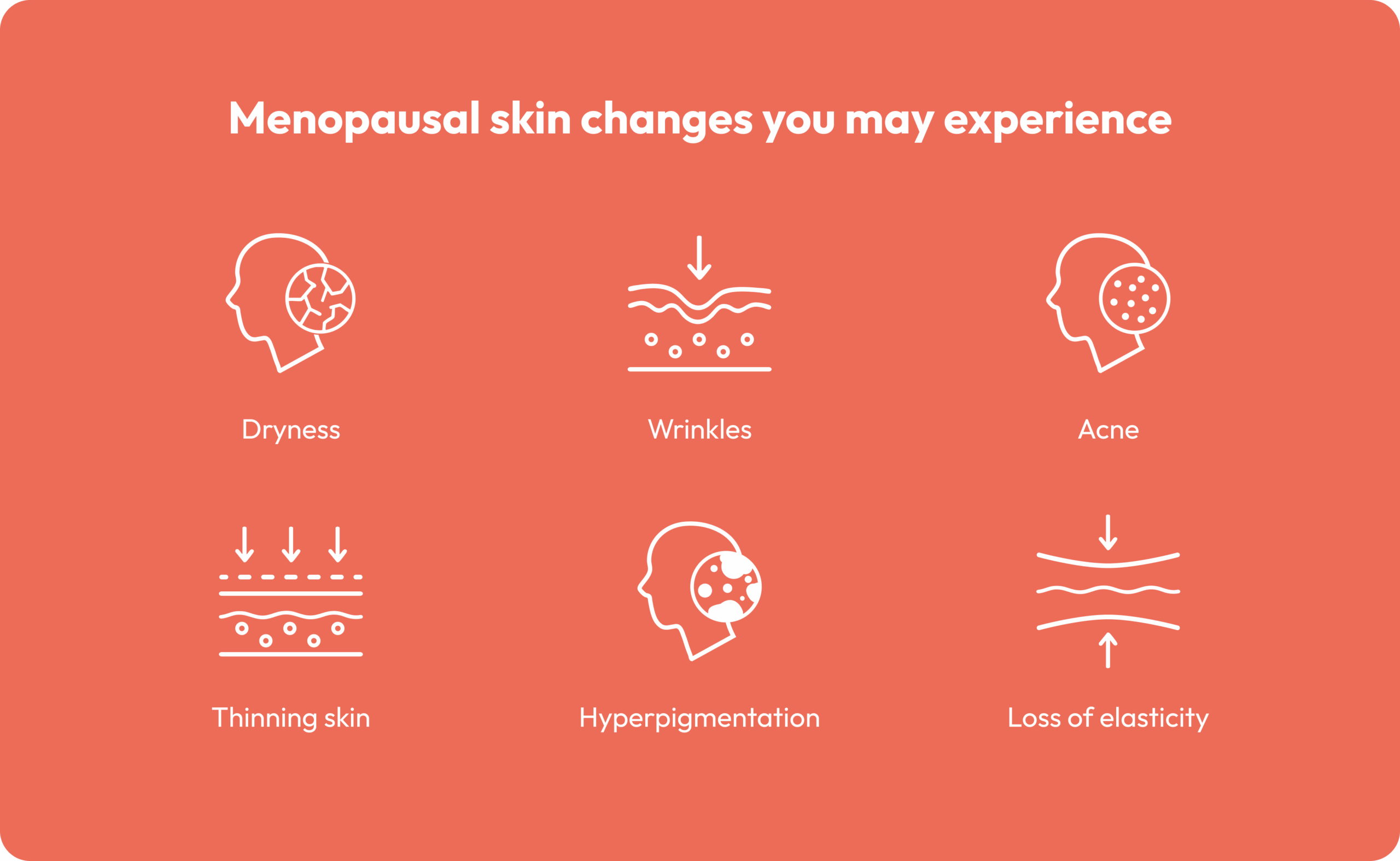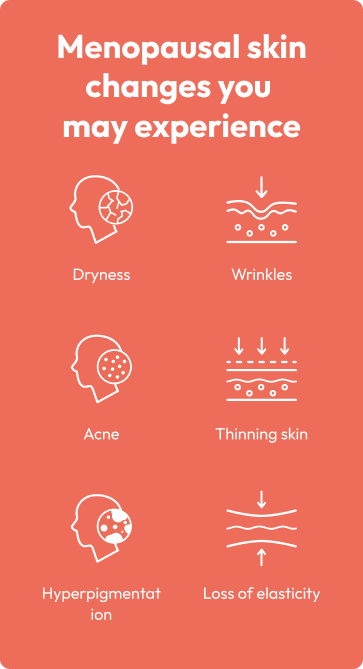Menopause & skin changes: Causes, symptoms, & treatments
You may not realize it at first, but the changes you’re seeing in your skin, from dryness to new or more visible wrinkles, thinning skin, seemingly fragile or delicate texture, or even surprise breakouts, may be tied to perimenopause or menopause. Many women notice these shifts long before they ever think to connect them to their hormones.
Skin changes are actually one of the most common signs that your hormones are beginning to fluctuate. Dryness, less bounce, more visible lines, and increased sensitivity often start in perimenopause and continue into menopause and beyond as you age.
Because your skin is your largest organ, even small hormonal drops can show up quickly, sometimes years before your periods stop. Even your scalp can become drier and produce less sebum, a natural, oily, waxy substance your sebaceous glands produce for moisture and protection.
In the sections ahead, we’ll talk about why your skin changes during the menopausal transition, the most common changes you may see, and how to care for your skin during this period of life.
Why your skin changes during menopause and perimenopause
Estrogen is a major supporter of skin health. It helps maintain collagen, elastin, and natural hydration. All of which help keep skin firm, smooth, and glowing.
As estrogen begins to fluctuate and eventually decrease, your skin’s structure and function shift. This can lead to:
- A weakened skin barrier (making skin more sensitive)
- Less sebum (natural oil), leading to dryness
- Slower wound healing, which can make bruising or cuts more noticeable
These changes aren’t random. In fact, they’re directly tied to the drop in estrogen. As this hormone declines, the systems that once kept your skin hydrated, strong, and elastic slow down too. That’s why skin changes are such a common and expected part of the menopause transition.


Most common skin changes during perimenopause & menopause
Dry, tight, or dehydrated skin
With less estrogen, your skin loses moisture more easily. This can lead to dryness, flakiness, irritation, tightness, and may even feel like wrinkles are more prominent, even if you’ve never had dry skin before.
Thinning skin and loss of firmness
Collagen and elastin naturally decline as your hormones shift, causing the skin to appear thinner or more fragile. You may notice sagging around your jawline, your cheeks, and your neck becoming more noticeable.
Fine lines, wrinkles, and crepey texture
When elasticity drops, fine lines show up more clearly. Skin may take on a crepey texture, especially on the neck, chest, arms, and around the eyes. You may notice lines on your forehead, near your eyebrows, near your eyes, sometimes referred to as crows feet, around your smile, and more.
Midlife acne and breakouts
Hormonal fluctuations can still trigger oil production in certain areas despite experiencing dryness and dehydration in others, leading to jawline, chin, or cheek breakouts, even if you never had acne before.
Increased sensitivity and irritation
A weaker skin barrier means products you’ve used for years may now sting, burn, or cause redness, despite working in the past. Your skin becomes more sensitive and more reactive. You’ll want to use gentle cleansing products free of dyes and parabens and use a daily moisturizer without any harsh chemicals.
Slower healing and bruising
Thinning skin and reduced collagen mean cuts take longer to heal, and bruises may appear more easily. So, if you pick at your acne and cause irritation, it will take longer to heal. If you bump your head or get a black eye, it may linger a bit longer.
Changes in pigmentation
Hormonal shifts can make dark spots more visible or create new discoloration, especially after sun exposure. Dark circles under your eyes, more focused pigmentation on the cheeks, whatever it is you may have, it can be heightened during this transitional period.
How to take care of your skin during perimenopause and menopause
Menopause hormone therapy (MHT)
MHT can help improve the skin changes that happen during perimenopause and menopause. By replenishing declining estrogen levels, MHT helps support collagen production, skin thickness, elasticity, and natural hydration.
Many women notice that with balanced hormones, their skin feels less dry, looks more supple, and has a healthier overall texture and appearance. While MHT isn’t a cosmetic treatment, restoring hormonal balance can help your skin function more like it used to. A QuickMD doctor can help you understand whether MHT is a safe and appropriate option for your skin concerns and overall health.
Cleanse your skin
Cleansing your skin is an important skin care step at any age, but especially as you age. Sometimes your skin needs a little boost from some extra moisture that you provide through a cleansing and moisturizing routine. There are several over-the-counter products dermatologists recommend and prescription products as well. You’ll want to opt for a cleanser that’s made for drier and sensitive skin. A creamy formula is ideal as an alternative to foam hydrating cleansers or gels, which can have the opposite effect of what you want.
Hydrate and keep hydrating
During perimenopause, menopause, and beyond, your skin becomes drier. It’s just a natural occurrence as you age and your hormones shift, which results in your oil glands not being as active as before. A heavier moisturizing cream like Vanicream is ideal. You’ll also want to be more mindful about your shower routine. Those almost scalding hot shower temperatures are going to dry your skin out even more. Putting your moisturizer on while your skin is still damp can also help boost hydration. Think of it as a necessary step once out of the shower.
Dr. Sherry shares:
“Keeping the skin hydrated, clean, and cared for will help prevent dryness. Other helpful daily hygiene rituals include using a gentle, non-fragranced soap and natural skin moisturizer daily.”
Don’t skip on sun protection
Even if you’ve spent years wearing sunscreen, your skin today has less natural protection. There are sunscreens that exist without the harsh chemicals, providing the same result as those popular brand names you can find on the shelves of any convenient store along the beach. If you wish not to use sunscreen, opt for a hat that covers your face and neck, wear sunglasses, or perhaps even opt for a neck gaiter, which can also cover parts of your face.
Eat antioxidant-rich foods
Collagen naturally declines just as estrogen naturally does. Collagen is what keeps your skin elastic. When you hear cosmetic commercials describing skin as youthful or plump, it’s usually in relation to collagen. Eating foods high in antioxidants like berries, leafy greens, tomatoes, carrots, and other fruits can support skin health. Try to incorporate these foods in your diet more purposefully.
Add soy to your diet
Soy contains isoflavones, which are plant-based compounds that can act similarly to estrogen in the body. A systematic review found that both oral and topical soy supplementation helped improve skin aging indicators (such as wrinkle depth, elasticity, and collagen content) in adult women.
While the ideal dose is still under study, research suggests that incorporating soy-rich foods (for instance, tempeh, miso, or soy protein) may offer real support for skin health during menopause and beyond.
Keep stress in check
Stress affects many aspects of your life, from your mood to your physical well-being to your skin. It can increase dryness, irritation, or sensitivity, and can even trigger conditions like psoriasis or eczema. Stress can also make it harder to keep up with your daily skincare routine.
Stress-reducing habits like yoga, meditation, stretching, journaling, or even short mindfulness breaks can help calm both your mind and your skin.
Dr. Sheryl Ross (Dr. Sherry), Chief Medical Officer of Women’s Health here at QuickMD shares, “As women age, they tend to be more sedentary and more stressed. Sleeping well can reduce mental stress, anxiety, depression, irritability, mood, and brain fog.” She also explains that “Making simple lifestyle adjustments to support healthy aging can help make the hormonal upheaval of perimenopause and menopause less disruptive and stressful.”
Being mindful about how much you’re allowing yourself to be stressed out and engaging in lifestyle changes can help you manage stress and stressful situations.
Move your body
Exercise supports your skin in more ways than you might expect. It reduces stress and boosts circulation, which naturally slows with age. Better circulation brings more oxygen and nutrients to the skin, helping it look brighter and healthier.
As Dr. Sherry puts it, “Exercise makes you feel more confident and helps ease the stress when dealing with menopausal symptoms.”
Noticing changes to your skin? See how hormone therapy can help restore your skin’s natural balance.
Hormonal shifts during menopause can leave your skin feeling drier, thinner, or more sensitive than before. These changes are common, but they don’t have to be permanent. QuickMD doctors can help you rebalance your hormones to support healthier skin, improved hydration, and a natural, renewed glow from within.
We just launched our Menopause Hormone Therapy Membership in select states, and your first month’s on us. You’ll get to meet with a doctor, ask all your questions, and see if treatment might help.
If you love it and want to keep going, it’s $ 79/month after that, with special member pricing on medication and regular access to your doctor. And if you decide it’s not for you – that’s totally fine too. Get started by booking your free visit now.

